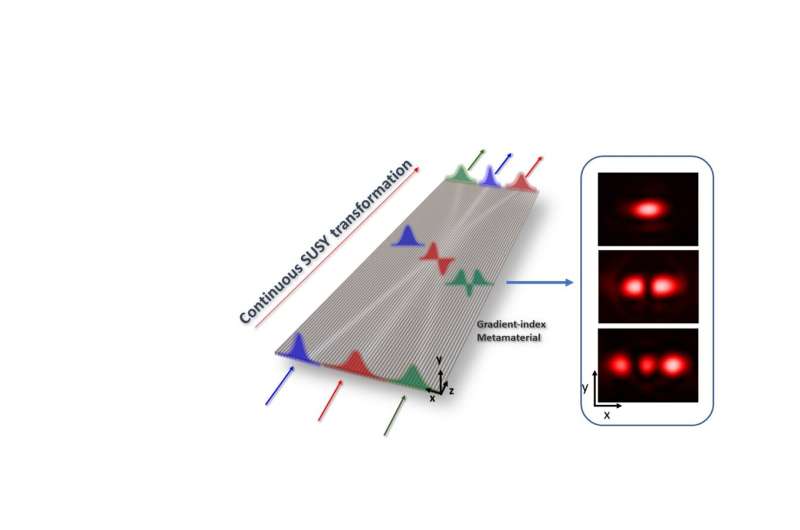Smooth, versatile on-chip light manipulation is now possible with supersymmetry

Transformation optics has formulated a versatile framework to mold the flow of light and tailor its spatial characteristics at will. The coordinate transformation often yields extreme material parameters unfeasible even with metamaterials.
In a new paper published in eLight, a team of scientists, led by Professor Liang Feng from the University of Pennsylvania, have developed a new chip that can transfer different optical states to switch light flows. Their paper, titled "Broadband continuous supersymmetric transformation: a new paradigm for transformation optics," seeks to provide an adaptable strategy to tame the flow of light.
Attempts at bending light on demand and arbitrarily transforming its spatial characteristics are rooted in the fundamentals of electromagnetics. The form-invariance of Maxwell's equations under coordinate transformations led to the formulation of transformation optics. Their equivalence allows for the rearrangement of electromagnetic fields in a given coordinate system. It has left open avenues to a series of intriguing functionality such as invisibility cloaking and illusion optics.
Metamaterials have excellent design flexibility and enable a wide range of optical properties. Experimental realization of transformation optics has been at a stalemate for a decade because of optical extremity and singularity often resulting from the transformation. Therefore, new schemes for transformation optics with broadband parameter values within achievable limits are essential.
For example, conformal mapping with the spatially varying local index of refraction had been demonstrated. This technique can perform the coordinate transformation using inhomogeneous Si nanostructures. It can yield delicate phase-front control for multicolor carpet cloaking. This approach elucidated the possibility of exploiting gradient-index (GRIN) to warp the space. However, a paradigmatic shift beyond traditional coordinate transformation is further required to achieve richer functionality other than bending the trajectories.
Here, the research team takes a different approach from conventional transformation optics: observing the Hamiltonian of the system under transformation. The invariance of the Hamiltonian under symmetry operation endows us with insights into how a system can be transformed with a conserved quantity. In particular, Supersymmetry (SUSY) features the degenerate eigenenergy spectra between two distinct Hamiltonians, which has facilitated advanced control of the spatial characteristics of light.
Strategic coupling between the original optical system and its dissipative superpartner has triggered intriguing applications such as high-radiance single-mode microlaser arrays and mode division multiplexing. These previous experimental studies are based on lattice Hamiltonians, which can be factorized via matrix operation. Hence, they constructed systems composed of many coupled discrete elements corresponding to coupled waveguides or resonators.
In contrast, the extended method of SUSY that can generate an infinite number of strictly isospectral potentials has remained experimentally unexplored since it requires an intrinsically different approach to realize arbitrary potentials. At the same time, its mathematical framework is ideal for the continuous Hamiltonian transformation to enable a distinct scenario for transformation optics.
The research team reported the first experimental demonstration of continuous SUSY transformation by designing a novel GRIN metamaterial on a Si platform. The idea is to construct a metamaterial that can emulate arbitrary potentials to achieve advanced light control through transforming the optical media under supersymmetry.
They utilized the synergy of supersymmetry and the metamaterial to design spatially varying dielectric permittivity. It constituted a two-dimensional map where arbitrary transformations are prescribed simultaneously to multiple optical states for routing, switching, and spatial mode shaping, while strictly maintaining their original propagation constants. Their result featured broadband continuous SUSY transformation optics. The interplay of supersymmetry and a metamaterial demonstrated in this study illuminated a novel path to fully utilizing a chip's spatial degrees of freedom for versatile photonic functionalities.
The team's continuous SUSY transformation approach is scalable to a higher number of eigenstates and free parameters. It applies to more complicated index distribution, creating an ideal platform for on-chip space-division multiplexing in information technologies. Additionally, further extending the SUSY transformation into higher dimensions may provide a design strategy to exploit the full potential of metamaterials in the three-dimensional space.
More information: Jieun Yim et al, Broadband continuous supersymmetric transformation: a new paradigm for transformation optics, eLight (2022). DOI: 10.1186/s43593-022-00023-1
Provided by Chinese Academy of Sciences





















